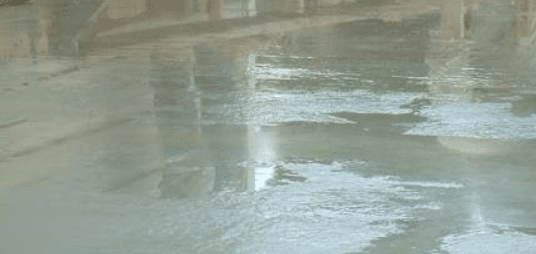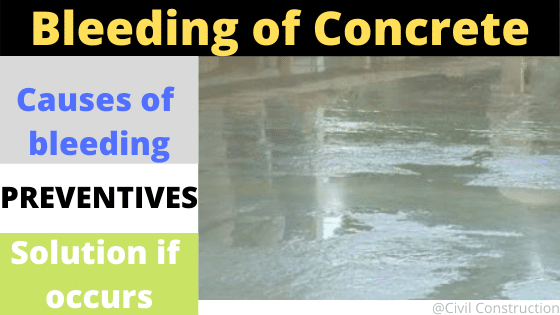In the construction site, you may have frequent observed the water layer on freshly levelled concrete surface. In simple word that floating water in the fresh concrete is called bleeding.
Table of Contents
Bleeding of concrete:
Bleeding of concrete is the particular form of segregation in which some form of water appear in the surface of fresh concrete after it has consolidated and before it is set. In a highly wet mix, badly proportioned and insufficiently mixed concrete, bleeding of concrete is predominantly observed.

The bleeding of water from bottom to top layer of concrete placed may causes continuous capillary action. This may create a permeable hardened concrete. The water bleed from the fresh concrete mix is likely to accumulate below the aggregate which creates water voids and reduces the bond between the aggregates and the paste. Shrinkage cracks may occurs in concrete due to excess mortar in the top layer of fresh concrete or evaporation of water from the fresh concrete more than that of bleeding rate. If excess amount of bleeding water accumulate on the surface of pavement slab, the bleeding water will flow out over the unsupported sides which causes collapsing of sides.
Causes of bleeding:
- Excess of water
- Inappropriate proportioning
- Insufficient mixing
- Over compaction
- Sedimentation of the solids due to compaction and self-weight of the solids
It is caused by the inability of the solid constituents of the mix to hold all of the mixing water.
Effects of bleeding of concrete:
- Decrease in strength of concrete
- Permeability of concrete
- Create water voids
- Reduce bonding between cement paste and aggregate
- Possibility of shrinkage cracks
Formation of a series of water channels some of which will extend to the surface
Preventive measures:
- Add minimum water content in the concrete mix, use chemical admixture to reduce water content to achieve required workability
- Proper proportioning of concrete mix and uniform and complete mixing.
- Use of finely divided pozzolanic materials reduces bleeding by creating a longer path for the water to traverse.
- Use of air-entraining agent is very effective in reducing the bleeding.
- Bleeding can be reduced by the use of finer cement or cement with low alkali content.
- Rich mixes are less susceptible to bleeding than lean mixes.
- Increase the amount of fine aggregate if sand is coarser (fineness modulus of 2.5 – 2.8) in mix and reduce aggregate proportionally.
Remedies of bleeding:
It is better to think about the possibility of bleeding before it causes severe damage. If there is too much problem of bleeding then it shall be solve by suitable remedies. Some of the methods are:
i. Controlled re-vibration of concrete : The poor bond between the aggregate and the paste or the reinforcement and the paste due to bleeding can be remedied
ii. Bad effect can be minimized by delayed in finishing operation
iii. Removal of water from concrete
iv. Increase the rate of evaporation by mechanical devices but rate of evaporation should not greater than rate of bleeding
Method of testing bleeding of water:
ASDM standard for measurement of rate bleeding,
Apparatus required
- Container of diameter 250 mm and height 280 mm
- Tapering rod for compaction
- Pipette to extract water
- Measuring cylinder
Procedure:
- A sample of concrete mix is prepared and filled in container with 50mm each layer for a depth of 250 ± 3 mm (5 layer).
- Each layer is tapered by giving stokes and the top surface is made smooth by troweling.
- The cylindrical container is kept in a level surface free from vibration at a temperature of 27°C ± 2°C. It is covered with a lid.
- Water accumulated at the top is drawn by means of pipette at 10 minutes interval for the first 40 minutes and at 30 minutes interval subsequently till bleeding ceases.
- To facilitate collection of bleeding water the container may be slightly tilted. All the bleeding water is collected in a jar.
Bleeding water percentage = total quantity of bleeding water / total quantity of water in sample of concrete *100
Since bleeding is not always bad and permissible may lower water-cement ratio and densified the concrete. But the excessive bleeding may causes severe effects mentioned above. In extreme cases, the bleeding water percentage reaches 20% which must be avoided.
ALSO READ

